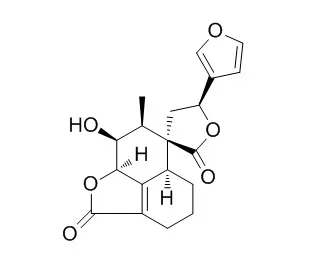| In vitro: |
| Chemical Research in Toxicology, 2007, 20(10):1393-1408. | | Identification of the protein targets of the reactive metabolite of teucrin A in vivo in the rat.[Reference: WebLink] | Covalent modification of proteins is associated with the toxicity of many electrophiles, and the identification of relevant in vivo protein targets is a desirable but challenging goal. Here, we describe a strategy for the enrichment of adducted proteins utilizing single-chain fragment variable (ScFv) antibodies selected using phage-display technology.
METHODS AND RESULTS:
Teucrin A is a furan-containing diterpenoid found in the herb germander that is primarily responsible for the herb's hepatotoxicity in rodents and humans following metabolic activation by cytochrome P450 enzymes. Conjugates of the 1,4-enedial derivative of Teucrin A, its presumed toxic metabolite, with lysine- and cysteine-containing peptides were synthesized and used to select ScFvs from a rodent phage-displayed library, which recognized the terpenoid moiety of the teucrin-derived adducts. Immunoaffinity isolation of adducted proteins from rat liver homogenates following administration of a toxic dose of Teucrin A afforded a family of proteins that were identified by liquid chromatography/tandem mass spectrometry. Of the 46 proteins identified in this study, most were of mitochondrial and endoplasmic reticulum origin. Several cytosolic proteins were found, as well as four peroxisomal and two secreted proteins. Using Ingenuity Pathway Analysis software, two significant networks involving the target genes were identified that had major functions in gene expression, small molecule biochemistry, and cellular function and maintenance. These included proteins involved in lipid, amino acid, and drug metabolism.
CONCLUSIONS:
This study illustrates the utility of chemically synthesized biological conjugates of reactive intermediates and the potential of the phage display technology for the generation of affinity reagents for the isolation of adducted proteins. | | Chemical Research in Toxicology, 1994, 7(6):850-856. | | Hepatotoxicity of Germander (Teucrium chamaedrys L.) and One of Its Constituent Neoclerodane Diterpenes Teucrin A in the Mouse.[Reference: WebLink] | The hepatotoxicity of the herbal plant germander and that of one of its major furanoneoclerodane diterpenes, Teucrin A, were investigated in mice.
METHODS AND RESULTS:
Teucrin A was found to cause the same midzonal hepatic necrosis as observed with extracts of the powedered plant material. Evidence that bioactivation of Teucrin A by cytochromes P450 (P450) to a reactive metabolite(s) is required for initiation of the hepatocellular damage is provided by results of experiments on the induction and inhibition of P450 and from studies on the effects of glutathione depletion. Pretreatment of mice with the P450 inducer phenobarbital enhanced the hepatotoxic response, as indicated by an increase in plasma alanine aminotransferase (ALT) levels and hepatic necrosis, while pretreatment with the P450 inhibitor piperonyl butoxide markedly attenuated the toxic response.
CONCLUSIONS:
Hepatotoxicity of Teucrin A also was increased following pretreatment with the inhibitor of glutathione synthesis buthionine sulfoximine.
Most importantly, the tetrahydrofuran analog of Teucrin A, obtained by selective chemical reduction of the furan ring, was not hepatotoxic, a result that provides strong evidence that oxidation of the furan ring moiety of the neoclerodane diterpenes is involved in the initiation of hepatocellular injury caused by germander. |
|






 Cell. 2018 Jan 11;172(1-2):249-261.e12. doi: 10.1016/j.cell.2017.12.019.IF=36.216(2019)
Cell. 2018 Jan 11;172(1-2):249-261.e12. doi: 10.1016/j.cell.2017.12.019.IF=36.216(2019) Cell Metab. 2020 Mar 3;31(3):534-548.e5. doi: 10.1016/j.cmet.2020.01.002.IF=22.415(2019)
Cell Metab. 2020 Mar 3;31(3):534-548.e5. doi: 10.1016/j.cmet.2020.01.002.IF=22.415(2019) Mol Cell. 2017 Nov 16;68(4):673-685.e6. doi: 10.1016/j.molcel.2017.10.022.IF=14.548(2019)
Mol Cell. 2017 Nov 16;68(4):673-685.e6. doi: 10.1016/j.molcel.2017.10.022.IF=14.548(2019)